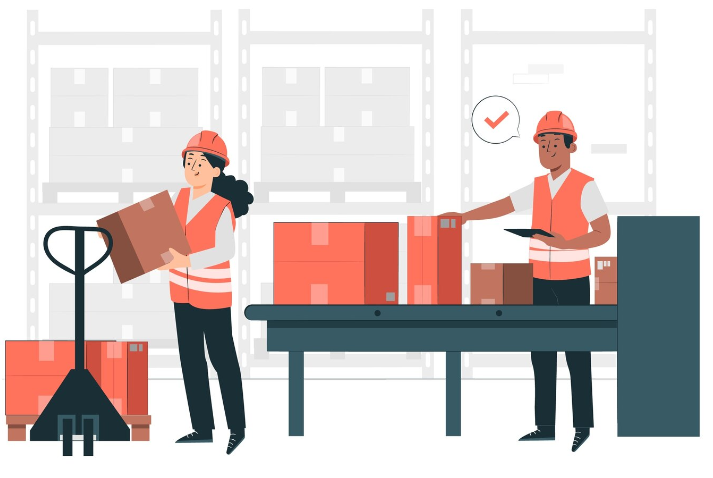Table of Contents
What Is Virtual Warehouse
Time: Jul 02,2024 Author: SFC Source: www.sendfromchina.com
As businesses strive for greater efficiency and agility, virtual warehouses have emerged as a powerful tool for inventory management. By utilizing cutting-edge technology and real-time data integration, virtual warehouses provide superior visibility and control over inventory across multiple locations.
This comprehensive article delves into the workings of virtual warehouses, their benefits, implementation strategies, and potential challenges, providing valuable insights for businesses looking to streamline their supply chain operations.
This comprehensive article delves into the workings of virtual warehouses, their benefits, implementation strategies, and potential challenges, providing valuable insights for businesses looking to streamline their supply chain operations.

1. Understanding Virtual Warehouse
A virtual warehouse is a revolutionary concept in the logistics and supply chain industry. Unlike traditional warehouses, which are physical spaces used to store goods, a virtual warehouse is a digitally managed inventory system. The virtual warehouse system allows businesses to track, manage, and distribute their inventory across multiple locations without the need for a single, centralized physical storage facility.
What Is a Virtual Warehouse?
A virtual warehouse leverages advanced software solutions to provide real-time visibility and control over inventory spread across different locations, including storage in multiple physical warehouses, distribution centers, retail stores, or even in transit. The primary goal of a virtual warehouse is to optimize the inventory management process, reduce storage costs, and improve the efficiency of order fulfillment.
Key Components of Virtual Warehousing
Inventory Management Software: Inventory management software is the backbone of the virtual warehouse, enabling businesses to track inventory levels, manage orders, and forecast demand.
Data Integration: Seamless integration with various data sources such as sales channels, suppliers, and logistics providers is crucial for real-time inventory visibility.
Automated Processes: Automation in inventory replenishment, order processing, and shipping helps reduce manual errors and improve operational efficiency.
Data Integration: Seamless integration with various data sources such as sales channels, suppliers, and logistics providers is crucial for real-time inventory visibility.
Automated Processes: Automation in inventory replenishment, order processing, and shipping helps reduce manual errors and improve operational efficiency.
2. How Do Virtual Warehouses Work

Virtual warehouses use sophisticated software systems and technologies to manage inventory across multiple locations without the need for physical consolidation in a single place. Here’s a closer look at how they operate:
Inventory Visibility and Control
The core functionality of a virtual warehouse lies in its ability to provide comprehensive visibility into inventory levels across all storage locations. It is achieved through advanced tracking systems that collect data from various sources, including RFID tags, barcodes, and IoT devices. The collected data is then centralized and analyzed in real-time to provide accurate insights into stock levels, product movements, and potential inventory issues.
Real-Time Data Synchronization
Real-time data synchronization is a critical aspect of virtual warehousing. By continuously updating inventory data, businesses can ensure that their inventory records are always accurate and up-to-date, which reduces the risk of stockouts, overstocking, and discrepancies between physical and recorded inventory levels.
Distributed Order Management
A virtual warehouse enables distributed order management, allowing businesses to fulfill orders from the most optimal location. It means that when an order is placed, the system can determine the best source of inventory based on factors such as proximity to the customer, stock availability, and shipping costs.
3. Why You Need Virtual Warehouses
Traditional on-premises data warehouses often struggle with the growing volume and complexity of data, leading to performance bottlenecks and high maintenance costs. In contrast, virtual warehouses leverage cloud infrastructure to offer virtually unlimited scalability, dynamically adjusting resources based on demand, ensuring optimal performance without significant upfront investments in hardware.
Virtual warehouses enhance data accessibility and collaboration, which are crucial in today’s globalized business environment. Teams across different geographies can access real-time data for decision-making, thanks to centralized access and seamless integration from various sources, which promotes collaboration and ensures all teams work with the most up-to-date information.
4. Benefits of Virtual Warehousing

Virtual warehouses offer a range of benefits that can significantly enhance the efficiency and effectiveness of inventory management and overall supply chain operations. Here are some key benefits:
Real-Time Inventory Tracking
One of the most significant benefits of virtual warehousing is real-time inventory tracking. With accurate, up-to-the-minute data on stock levels, businesses can make informed decisions about inventory management, reducing the risk of overstocking or stockouts.
Efficient Space Utilization
Virtual warehousing allows businesses to utilize their storage spaces more efficiently. By distributing inventory across multiple locations and optimizing storage based on demand patterns, companies can reduce the need for large, centralized warehouses.
Reduced Operational Costs
By leveraging existing storage spaces and optimizing inventory management, virtual warehouses can significantly reduce operational costs, including savings on rent, utilities, staffing, and other expenses associated with maintaining physical warehouses.
Enhanced Supply Chain Agility
Virtual warehouses enable businesses to respond quickly to changes in demand, supply chain disruptions, and market trends. Agility is crucial for maintaining a competitive edge in today’s fast-paced business environment.
Better Demand Forecasting
With access to real-time inventory data and advanced analytics, businesses can improve their demand forecasting accuracy. It also helps optimize inventory levels, reduce excess stock, and minimize the risk of stockouts.
5. Implementing Virtual Warehousing in Your Business
Implementing a virtual warehouse in your business involves several key steps, from assessing your current needs to choosing the right technologies and training your team. Here’s a comprehensive guide on how to implement a virtual warehouse:
Assess Your Current Inventory Management System
Before implementing a virtual warehouse, it’s essential to assess your current inventory management system. Identify any inefficiencies, inaccuracies, and pain points that need to be addressed. And this measure will help you understand the specific requirements for your virtual warehouse solution.
Choose the Right Technology
Selecting the right technology is critical for the success of your virtual warehouse. Look for inventory management software that offers real-time tracking, data integration, and automation capabilities. Ensure that the software is scalable and can adapt to your business’s evolving needs.
Integrate Data Sources
Integrating data from various sources is crucial for providing a comprehensive view of your inventory including data from sales channels, suppliers, logistics providers, and internal systems. Ensure that your virtual warehouse solution can seamlessly integrate with these data sources to provide accurate and real-time inventory insights.
Train Your Team
Implementing a virtual warehouse requires a shift in how inventory is managed and controlled. It’s essential to train your team on the new system, ensuring they understand how to use the technology and follow the new processes. Training your team will help in maximizing the benefits of your virtual warehouse solution.
Monitor and Optimize
Once your virtual warehouse is up and running, it’s crucial to continuously monitor its performance and make necessary adjustments. Use analytics and reporting tools to identify areas for improvement and optimize your inventory management strategies.
6. Challenges and Consideration
While virtual warehousing offers many advantages, it also comes with challenges and considerations:
Initial Investment: Implementing advanced technologies can require significant upfront investment.
Integration: Ensuring seamless integration with existing systems and processes can be complex.
Data Security: Protecting sensitive inventory data from cyber threats is crucial.
Change Management: Adapting to new technologies and processes requires effective change management strategies.
Initial Investment: Implementing advanced technologies can require significant upfront investment.
Integration: Ensuring seamless integration with existing systems and processes can be complex.
Data Security: Protecting sensitive inventory data from cyber threats is crucial.
Change Management: Adapting to new technologies and processes requires effective change management strategies.
7. Get Started with SFC Services
SFC stands at the forefront of order fulfillment with cutting-edge facilities in Shenzhen, China. Utilizing sophisticated software, we specialize in seamless and trustworthy fulfillment solutions for ecommerce, dropshipping, and crowdfunding platforms. At SFC, we are dedicated to accelerating your business growth through secure warehousing, efficient processing, customizable packaging options, and adaptable shipping strategies while saving you time and money.
Whether you have or do not have a fulfillment partner, particularly your products manufactured in China, you should consider SFC. Click the button below and get help from SFC logistics experts.
Whether you have or do not have a fulfillment partner, particularly your products manufactured in China, you should consider SFC. Click the button below and get help from SFC logistics experts.
What Makes SFC Special
Over 17 Years of 3PL and Order Fulfillment ExperienceAll-in-one Tracking Number
Popular Platform API Integration
30 Days of Free Storage
No Hidden Fee
Custom Packaging
Worldwide shipping solutions
Value-added Services
8. FAQs about Virtual Warehouse
What is a virtual warehouse?
A virtual warehouse is a system that uses advanced technologies to manage inventory across multiple locations without the need for physical consolidation in a single place.
How does a virtual warehouse differ from a traditional warehouse?
Unlike traditional warehouses, virtual warehouses leverage cloud-based solutions, AI, IoT, and other technologies to optimize inventory management, providing greater flexibility and efficiency.
What are the benefits of using a virtual warehouse?
Benefits include increased efficiency, better decision-making, flexibility, and reduced operational costs.
How can I implement virtual warehousing in my business?
Start by assessing your needs, choosing the right technology, training your team, and continuously monitoring and optimizing the system.
What challenges should I consider when implementing virtual warehousing?
Consider challenges such as initial investment, system integration, data security, and change management.
 Post Views:788
Post Views:788
Copyright statement: The copyright of this article belongs to the original author. Please indicate the source for reprinting.
Previous Post
Next Post
TAGS
Hot Research
Get a Custom China Fulfillment Solution with FREE Storage for 30 Days
 Want to know about our services, fees or receive a custom quote?
Want to know about our services, fees or receive a custom quote?
 Please fill out the form on the right and we will get back to you within a business day.
Please fill out the form on the right and we will get back to you within a business day.
 The more information you provide, the better our initial response
will be.
The more information you provide, the better our initial response
will be.






 TAGS:
TAGS: